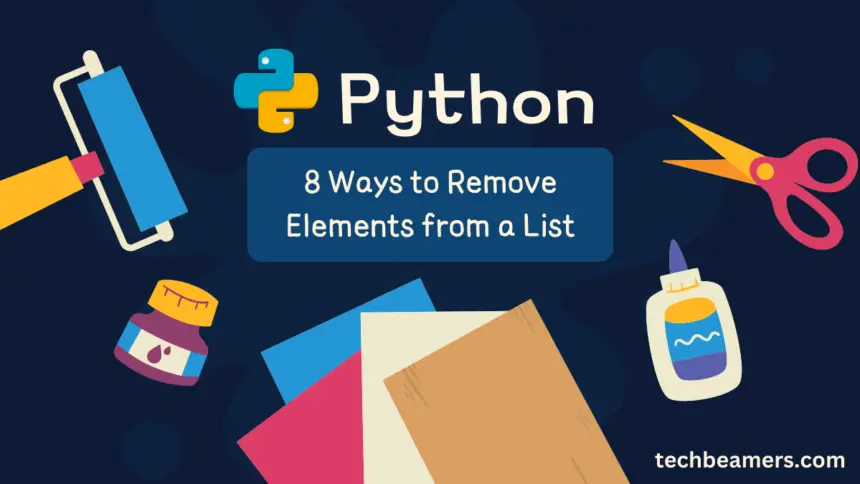Hi, today’s tutorial brings you various techniques to remove elements from a Python list. Manipulating lists is a basic operation in Python programming. One of the main aspects is the efficiency of the approach you choose to remove elements.
Understand How to Remove Elements from a List in Python
We will cover a range of methods, from basic and straightforward approaches to more advanced techniques that cater to specific requirements.
There can be a variety of situations when you need to remove elements from a list. Similarly, Python provides various methods to get through this task. Let’s check out each of such methods one by one.
Method 1: Using List.remove()
The remove() method is a simple and direct way to eliminate a specific element from a list. This method targets the first occurrence of the specified value and removes it. Let’s walk through an example:
# Example 1.1: Using remove() to delete an element
tasks = ['task1', 'task2', 'task3', 'task4', 'task5']
completed_task = 'task3'
# Mark the specified task as completed
if completed_task in tasks:
tasks.remove(completed_task)
print(f"'{completed_task}' marked as completed.")
print("Updated Tasks:", tasks)
else:
print(f"'{completed_task}' not found in the tasks.")Output:
'task3' marked as completed.
Updated Tasks: ['task1', 'task2', 'task4', 'task5']In this example, the first occurrence of ‘task3’ is removed from the list using the remove() method.
Method 2: Using List Slicing
Slicing is a two-fold technique that not only extracts elements from a list but also can remove specific elements. By combining the elements before and after the target element, you effectively exclude it. Let’s see this in action:
# Example 2.1: Using slicing to remove/skip a song
playlist = ['Song 1', 'Song 2', 'Song 3', 'Song 4', 'Song 5']
song_to_skip_index = 2
# Skip the song at the specified index
playlist = playlist[:song_to_skip_index] + playlist[song_to_skip_index + 1:]
print("New Playlist:", playlist)Output:
New Playlist: ['Song 1', 'Song 2', 'Song 4', 'Song 5']Here, we utilized list slicing to eliminate the element at index 2 ('Song 3') from the list.
Method 3: Using List Comprehension
List comprehensions offer a concise and readable way to modify lists. By specifying a condition that excludes the undesired element, you can effortlessly create a new list without it. Let’s explore this method:
# Example 3.1: Using list comprehension to filter out an element
animals = ['lion', 'elephant', 'tiger', 'giraffe']
element_to_remove = 'tiger'
animals = [animal for animal in animals if animal != element_to_remove]
print(animals)Output:
['lion', 'elephant', 'giraffe']In this example, a new list is created by excluding the element 'tiger' using list comprehension.
Method 4: Remove Using List.pop()
The pop() method not only retrieves and returns the value of a specified index but also removes the corresponding element from the list. This method is particularly useful when you need to work with the removed element after deletion. Let’s see how it works:
# Example 4.1: Using pop() to remove and retrieve an element
cities = ['New York', 'London', 'Paris', 'Tokyo']
index_to_remove = 2
removed_city = cities.pop(index_to_remove)
print(f"Removed city: {removed_city}")
print(cities)Output:
Removed city: Paris
['New York', 'London', 'Tokyo']In this case, we called the list’s pop() method to remove the city at index 2 ('Paris') and stored in the variable removed_city.
Method 5: Remove Using del
The del statement is a powerful tool for removing elements from a list. It allows you to delete elements based on their index or delete the entire list itself. Let’s focus on using del to remove a specific element:
# Example 5.1: Using del to remove an element by index
languages = ['Python', 'Java', 'C++', 'JavaScript']
index_to_remove = 1
del languages[index_to_remove]
print(languages)Output:
['Python', 'C++', 'JavaScript']In this example, the del operator removed the element at index 1 ('Java') from the list.
Method 6: Use filter() Function
The filter() function is a higher-order function that can be employed to create an iterator of elements for which a specified function returns True. By using filter() with a lambda function, you can effectively remove elements based on a condition. Let’s see this method in action:
# Example 6.1: Using filter() to remove elements based on a condition
empl_ratings = [4.5, 3.2, 4.8, 2.5, 5.0, 3.7, 4.1]
avg_rating = 3.5
# Filter out ratings below the threshold
empl_ratings = list(filter(lambda rating: rating >= avg_rating, empl_ratings))
print("Filtered Ratings:", empl_ratings)Output:
Filtered Ratings: [4.5, 4.8, 5.0, 3.7, 4.1]In this example, we got the Python filter() function to remove two elements '3.2‘ and '2.5‘ from the list.
Method 7: Using numpy Library
For numerical lists, the numpy library provides a powerful and efficient way to remove elements. The numpy.delete() function allows you to remove elements based on their indices. Let’s explore this method:
# Example 7.1: Using numpy.delete() to remove elements by index
import numpy as npy
# Example: Removing Songs Based on User Preferences
playlist = npy.array(['Song A', 'Song B', 'Song C', 'Song D', 'Song E'])
songs_to_remove_indices = [1, 3]
# Ensure the indices are valid before removing
valid_indices = [i for i in songs_to_remove_indices if i < len(playlist)]
# Remove songs based on user preferences if indices are valid
if valid_indices:
playlist = npy.delete(playlist, valid_indices)
print("Updated Playlist:", playlist.tolist())
else:
print("Invalid indices. No changes made to the playlist.")Output:
Updated Playlist: ['Song A', 'Song C', 'Song E']Here, elements at indices 1 and 3 are removed from the numerical list using numpy.delete().
Method 8: List.clear() to Remove Elements
The clear() method provides a straightforward way to remove all elements from a list, effectively emptying it. This method is particularly useful when you need to reset or initialize a list without creating a new one. Let’s see how it works:
# Example: Clearing Shopping Cart
cart = ['item1', 'item2', 'item3', 'item4', 'item5']
# Clear the shopping cart before adding new items
cart.clear()
print("Cleared Cart:", cart)Output:
Cleared Cart: []In this example, the clear() method is applied to the list, resulting in an empty list.
More Examples
There can be various scenarios where we can utilize these Python methods to remove elements from a list. Below, we are trying to cover a few of them.
Scenario 1: Removing Invalid Usernames
Suppose you have a list of usernames, and you want to remove those that do not meet certain criteria (e.g., usernames with less than 5 characters). You can use list comprehension for this task:
# Example: Remove invalid usernames using list comprehension
usernames = ['Salma_Beg', 'Asima Khan', 'Jeba', 'Anju', 'Manju']
min_length = 5
usernames = [username for username in usernames if len(username) >= min_length]
print(usernames)Output:
['Salma_Beg', 'Asima Khan', 'Manju']Here, we removed usernames with less than 5 characters from the list.
Scenario 2: Updating a Shopping Cart
Imagine you have a shopping cart represented as a list, and you want to remove an item that the user has decided not to purchase. You can use the remove() method for a specific item:
# Example: Remove Tool from Dev's Toolkit
dev_tools = ['IDE', 'Version Control', 'Debugger', 'Code Formatter']
tool_to_remove = 'Debugger'
# Remove the specified tool from the dev's toolkit
dev_tools.remove(tool_to_remove)
print("New Dev's Toolkit:", dev_tools)Output:
New Dev's Toolkit: ['IDE', 'Version Control', 'Code Formatter']Here, the ‘cherry’ item is out of the shopping cart based on the user’s decision.
Scenario 3: Dynamic Data Filtering
Consider a situation where you have a list of data points, and you want to dynamically filter out elements that don’t meet certain conditions. You can use the filter() function for this purpose:
# Example: Dynamic data filtering using filter()
data_points = [24, 36, 48, 12, 60, 72, 84, 96]
threshold = 50
data_points = list(filter(lambda x: x >= threshold, data_points))
print(data_points)Output:
[60, 72, 84, 96]Here, we removed elements below the threshold of 50 from the list of data points.
These real-world examples showcase how the above methods remove elements from lists and their usage in practical programming scenarios. By understanding these use cases, you can better grasp the applicability and versatility of each method in your projects.
Summary
In this tutorial, we have covered a variety of ways to remove elements from a Python list. Each method offers its own advantages, and the choice of which to use depends on what your program needs. Whether you like the simplicity of the remove() method or the flexibility of list comprehensions, it’s up to you.
You’ve got a solid understanding of tweaking lists in Python. Give these methods a spin in your projects to get good at picking the right one for the job. However, you may also visit the following link from the Python official doc for quick reference.
Enjoy Coding!









